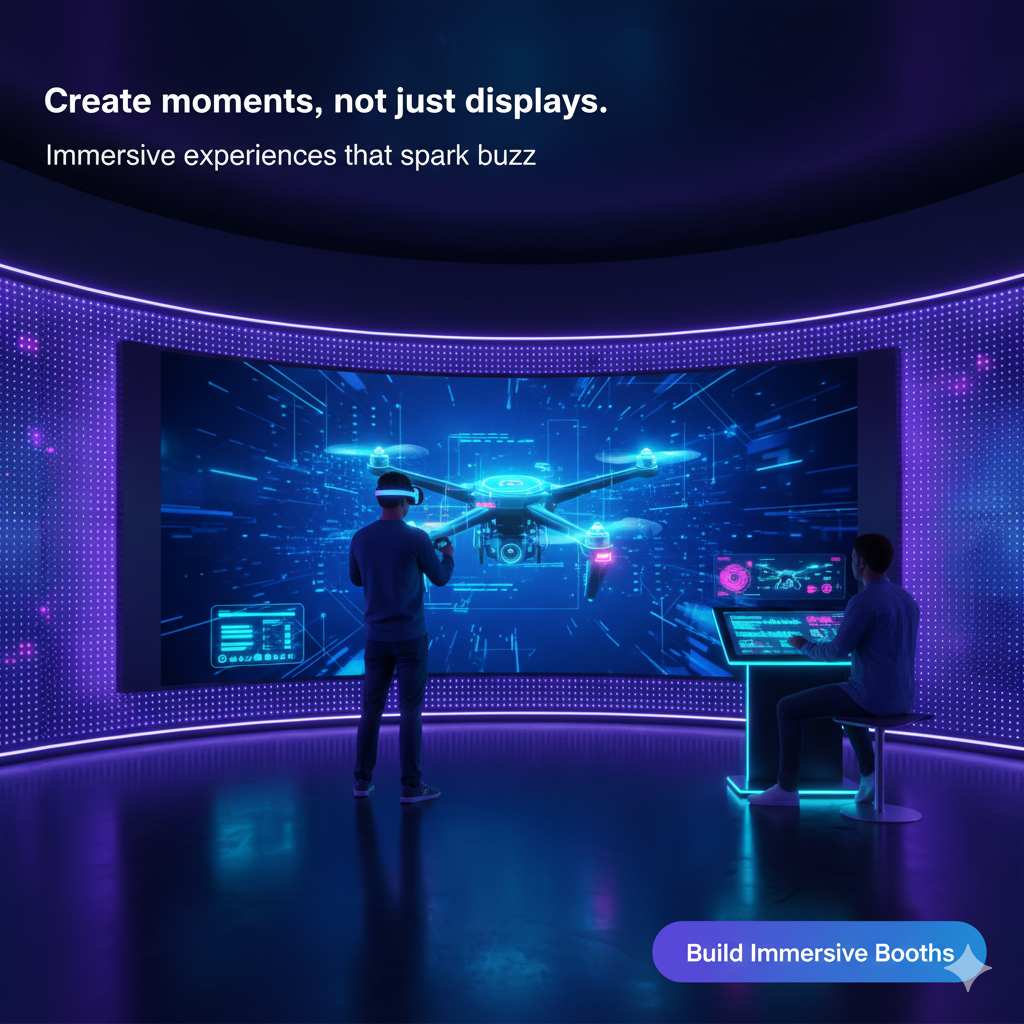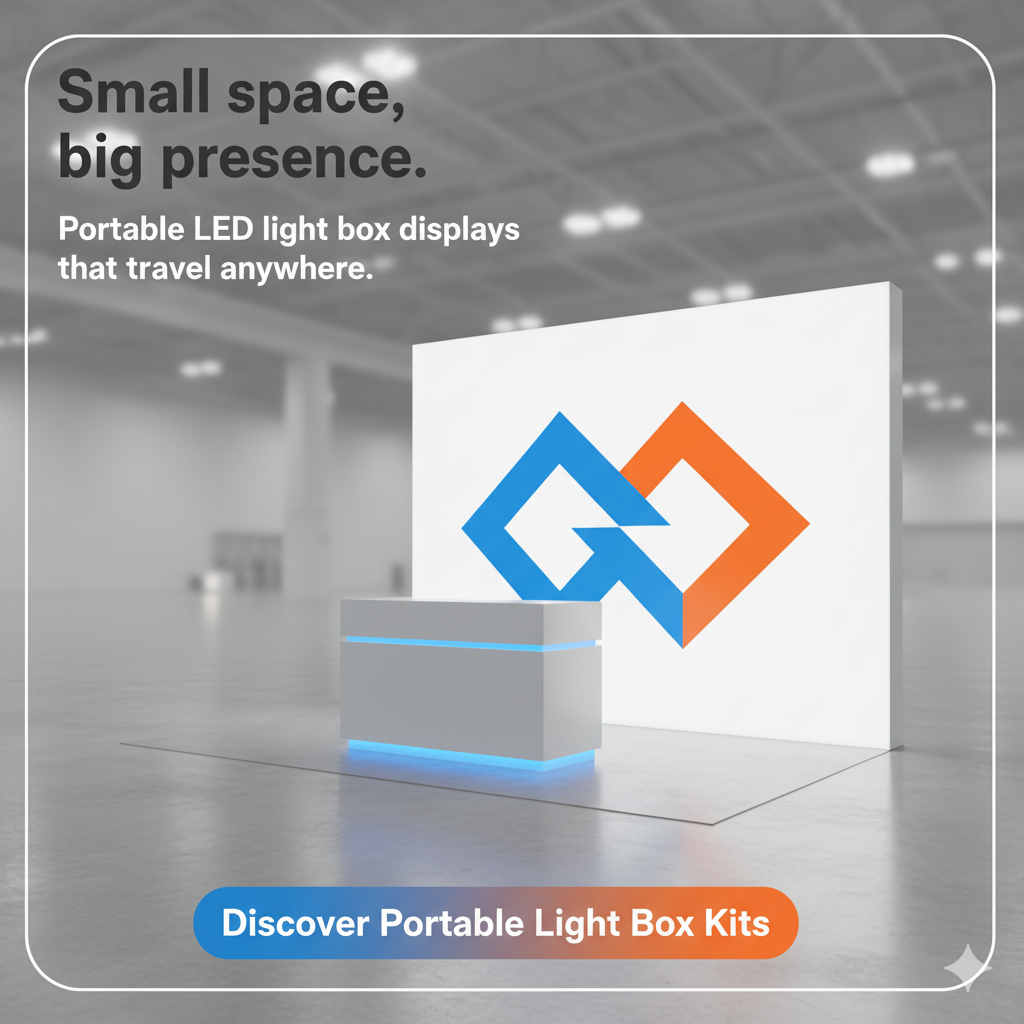Trade show booth design can make or break your exhibit success. A well-designed booth grabs attention, reinforces your brand, and guides visitors to your message. Experts note that simplicity often wins – for example, keeping up to 40% of your booth space blank can prevent visitor overload.
Effective lighting and cohesive branding are also key. Spotlights highlight featured products, and backlit displays draw eyes, while ambient lighting creates a welcoming atmosphere.
With these principles in mind, the following trade show booth ideas show how to light up your booth and make a memorable impact, no matter the size of your exhibit space.
1. Illuminated Backdrop Walls for Maximum Impact
One surefire way to stand out is with a brightly lit graphic wall or trade show backdrop. A backlit display wall instantly grabs attention in a sea of booths. Use bold, high-contrast graphics and our LED lightbox panels to make your logo and key message pop.
For example, a full-width fabric backwall with integrated LED lighting turns your graphics into a glowing attraction. This is ideal for 10×10 or 10×20 spaces where you want a clear focal point without cluttering the floor.
For standard inline booths (10×10 or 10×20), a 240 cm (7.9′) height kit provides ample visibility without excessive ceiling height. In any case, a lighted backdrop leverages strategic lighting to guide visitors’ eyes to your brand.
2. Interactive Tech Integration with Digital Displays
Modern attendees expect engagement. Integrating technology is a top trade show display idea. Think touchscreens, tablets, VR demos, or even holograms. For example, position a touchscreen kiosk or video wall within your booth to invite hands-on exploration of your product.
Gamified elements (like a digital quiz or prize wheel) can draw a crowd. According to industry trends, leading brands are turning booths into multi-sensory experiences with immersive tech. This could mean VR headsets for a demo, or live social media feeds projected on your back wall.
This kind of booth thrives on a larger space (10×20 or 20×20) so people can gather around tech stations. A Height 240 cm (7.9′) Kit is great here: it’s tall enough to mount screens or graphic panels at eye level, yet not so tall it overwhelms an inline booth.
3. Modular Multi-Zone Layouts for Flexibility
A modular layout helps you make the most of your space. With the MLB Kit I 240, you can create clear visitor pathways using panels and counters that move wherever you need them. You can set up a reception counter in front, place a demo station along one side, and add a small lounge on the other end.
The same booth kit adapts well to different floor sizes. In a 20×20 island booth, the MLB Kit I 240 can create three connected walls that define each zone. In a smaller 10×20 booth, two walls and a center counter will still give you a clean and functional layout.
Portability is another benefit. The MLB Kit I 240 has lightweight parts that one person can carry and set up fast. The 240 cm (7.9 feet) height gives you enough vertical room for impactful graphics while staying compact for most standard booth rules.
4. Sustainable and Eco-Friendly Exhibits
Audiences notice when companies use eco-friendly materials and practices. Consider an exhibit with green accents or real plants, combined with energy-efficient LED lighting. For example, use natural woods or recycled fabrics for counters and pair them with LED backlit panels.
The compact Height 240 cm (7.4′) Kits suit a “green” minimalist layout: keep graphics clean and messaging focused on sustainability. In larger 20×20 spaces, combine multiple modular kits to form an open, airy environment. Highlight that ethos on your display wall with clever messaging and even QR codes linking to your sustainability efforts. This not only cuts waste but also shows your brand cares about more than just sales.
Ask us about sustainability options like printing on recycled fabrics or recycling old banners.
5. Open Lounge and Meeting Areas
Sometimes the best design gives people room to breathe. Instead of crowding walls, create an open meeting space within your booth. For example, push your graphic wall back and place bar-height tables or lounge chairs in front. This invites visitors to step in, sit, and have longer conversations. Add spot lighting on your seating area to make it cozy.
For this layout, the Height 240 cm (7.9′) Kit is a great choice. It provides a prominent branded backdrop (for your logo on fabric) while allowing plenty of room below. If your space is 20×20, you could even create an “island lounge” with seating on two sides and a high LED wall on the third.
6. Eye-Level and Hanging Installations
Hanging signage or overhead graphics can capture attention across the aisle. If venue rules permit, suspend a backlit logo or fabric sign above your booth. Even in a 10×10 booth, a hanging element (e.g. a lightbox cube or banner) adds an unexpected twist. In a 20×20 island, you have room for a sizable hanging structure like a glowing “cloud” or an LED sphere with your emblem.
For example, mount one of our Height 250 cm (8’+) Kits to reach the ceiling rails, then hang a smaller illuminated sign from it. The tall kit provides sturdy support and ensures visibility from afar. Taller structures and hanging elements significantly boost visibility because attendees naturally look up.
7. Immersive Multi-Sensory Experiences
Could your booth offer live demos, a VR tour of your product, or a TV or monitor playing engaging content? For instance, play a short video with surround sound on a loop, or diffuse a light scent that ties to your brand (like a fresh coffee aroma for a coffee roaster). Hosting live product demos or mini-workshops can turn your space into an event. At major shows, experiential booths (like game stations or photo booths) create buzz and social sharing.
If you plan on high-tech exhibits, you’ll want space – a 20×20 “premium” booth is perfect. Use a combination of Height 240 cm and Height 250 cm kits to build an immersive environment. For example, curve two lightbox walls to form a small theater area with a screen. LED backlit walls around it can display themed graphics.
8. Compact Kiosks and Pop-up Stations (10×10 Booths)
For startups and small teams, a compact 10×10 portable display booth should still look professional. Focus on a single statement wall and a clean layout. A tall portable mobile lightbox on the back wall displays your logo and tagline. Use a small counter or demo podium in front – make sure it’s branded too. The rest of the space can be kept open or used for a narrow table.
One small booth idea is a “hub-and-spoke” layout, where the lightbox wall is the hub and a couple of wing displays or banner stands (with backlighting) form the spokes. This maximizes every inch in your 10 X 10 Trade Show Booths. Remember, a neatly organized small booth can have a big impact if visitors can easily see and access your message.
Final Thoughts
Effective booth design combines creativity with strategy. By using bright backlit walls, smart layouts, and modular flexibility – along with the right trade show kit – you can turn any exhibit into a head-turner.
A well-lit, well-planned booth not only draws visitors but also reinforces your brand’s professionalism and innovation. Start with these ideas, tailor them to your brand, and watch your trade show presence shine.





